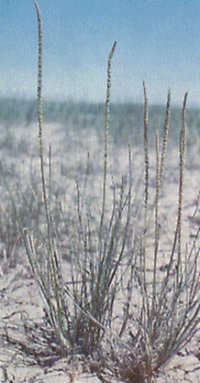ARROWGRASS

Description
Arrowgrass has fleshy, dark green, half rounded, grasslike leaves that grow from the base of the plant. Although clumps of leaves are only 6 to 18 inches tall, slender flower stalks reach a height of 3 to 5 feet. Small, green flowers appear close together along the upper part of the stalk early in the season. Later, the flowers delvelope into golden brown fruits. The plant is a perennial in the arrowgrass family.

Sheep and cattle may be poisoned by eating arrowgrass.
Its leaves contain hydrocyanic or prussic acid-atoxic
substance.Cud-chewing animals may be severely affected
if they eat large amounts of leaves in a short time.
Species of arrowgrass that poison livestock are
widely distributed in marshy pastures and native grass
hay areas throughout the United States.
As long
as arrowgrass has adequate moisture, it does not cause
poisoning. When growth is stunted from lack of moisture or an early frost, plants quickly become toxic. Arrow
grass causes the same type of poisoning as chokeberry
which also contains hydrocyanic acid.

Where and When It Grows
Arrowgrass grows best in soil covered with water. In such soil it may spread over large areas. In moist soil or near springs, it sometimes grows in small patches. Arrowgrass starts growth in the spring.

How It Affects Livestock
How much arrowgrass does it take to poison sheep or cattle? This depends on the toxicity of the plants and the rate at which the plants are eaten. About 1/50 of an ounce of hydrocyanic acid (1/4 to 3 pounds of stunted arrowgrass) will kill a 600-pound animal. The toxic dose must be eaten at one time to cause death, because the poison is not cumulative. Death results from respiratory failure.

Signs Of Poisoning
1. Nervousness
2. Abnormal breathing, either very rapid or slow and deep.
3. Trembling or jerking muscles.
4. Blue coloration of the lining of the mouth.
5. Spasms or convulsions continuing at short intervals until respiratory failure causes death.

BACK TO INDEX
H O M E
Would You Consider Signing
My Book?








